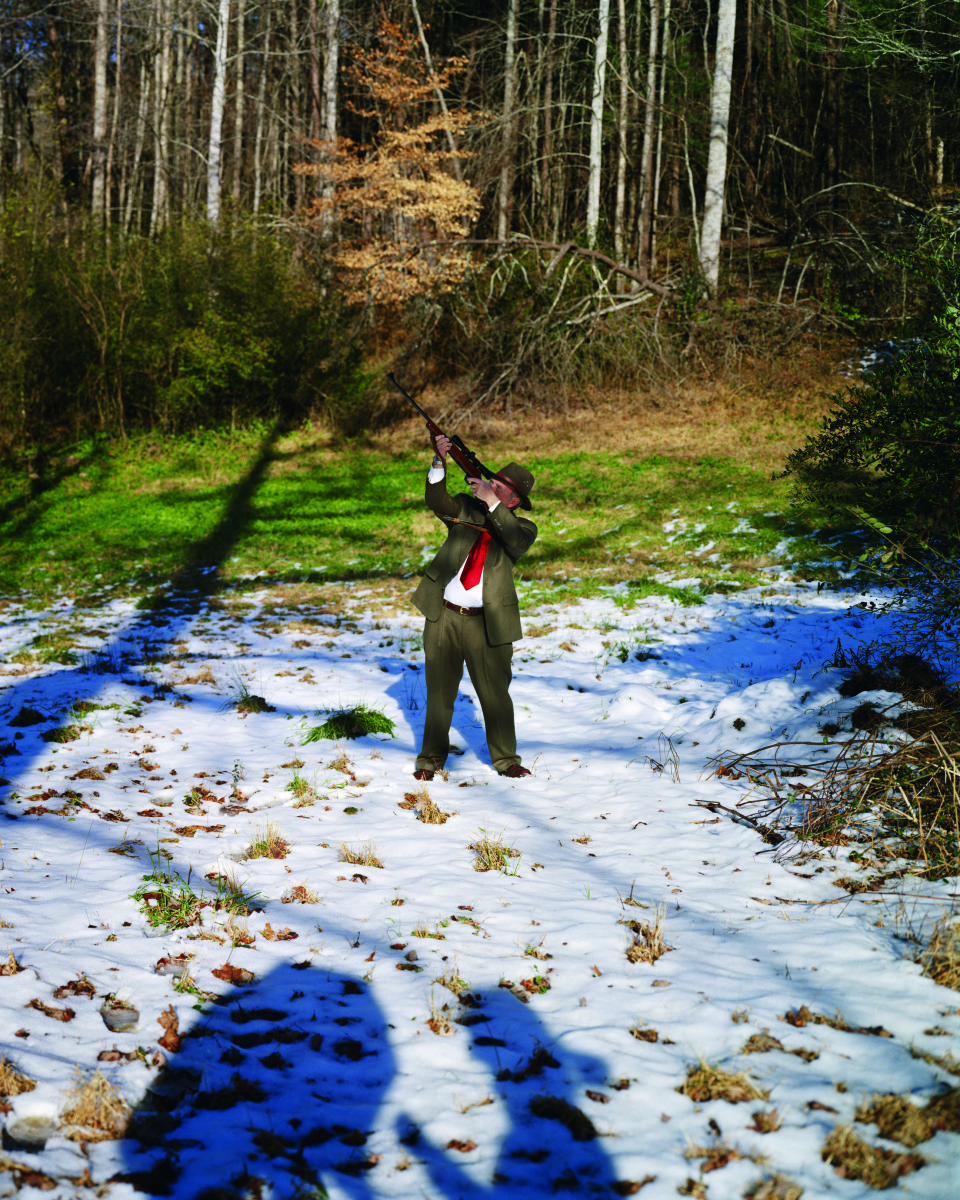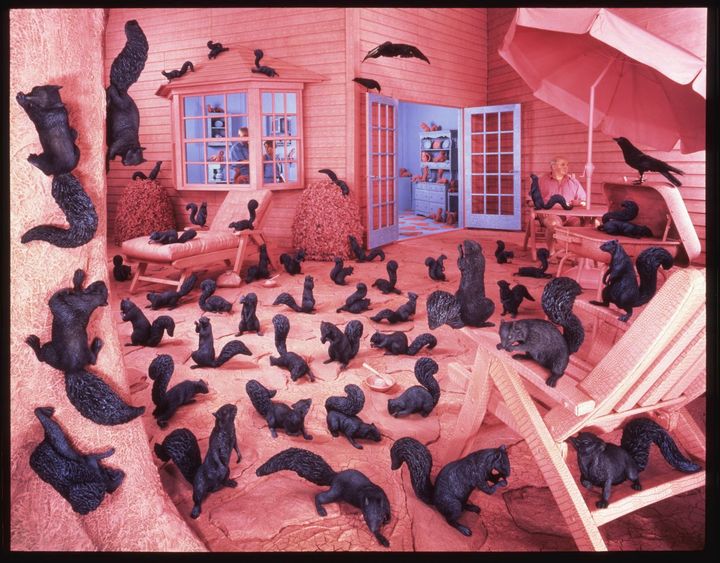Deconstructing the Domestic

Sandy Skoglund (American, born 1946), Gathering Paradise (detail), 1991, dye coupler print, 47 × 60 1/2 inches, gift of Mr. and Mrs. James L. Henderson, III, 1991.270. © Sandy Skoglund.
Women have long been associated with the domestic sphere, and women photographers are no exception. Soon after the introduction of the snapshot camera around 1900, women were encouraged to document family life and the home and were seen as especially suited to photographing children. More recently, many women artists have interrogated these associations between gender and the private sphere even as they stake their claim on this territory. The photographs in this section offer different reflections—some tender and introspective, others darkly humorous—of domestic spaces, situations, and experiences.
-

Irina Rozovsky elevates photographs she takes in her day-to-day life to the status of precious objects by pairing images with old frames found in antique stores and on eBay. Her Miracle Center series is, she explains, an “invitation to play with time and visual space.” The images are transformed by the frame, influenced by its color, shape, ornamentation, and the number of images it holds. She is particularly drawn to “travel frames,” compact frames that were intended to be carried during travel, thus keeping the tender feeling of home or another person close to heart.
Untitled, from the Miracle Center series
Irina Rozovsky, American, born Russia, born 1981
2019
Inkjet print (with artist frame)
3 × 2 inches
Gift of Dr. Joe B. Massey
2021.61 -

Susan Harbage Page’s artwork examines feminism and race in a variety of media. In this series, sitters wear versions of Ku Klux Klan hoods that Page crafted from contemporary fabrics. The images bring the viewer face to face with the persistence of racism, even if camouflaged, in society. By sewing the hoods and robes, she ties the subject matter to a domestic feminine presence—the protection of which Klansmen often used as justification for their violence. Page presents the South as both a beloved home and a place of division.
English Garden Toile, from the Postcards from Home series
Susan Harbage Page, American, born 1959
2010
Pigmented inkjet print
47 × 32 inches
Gift of Lucinda W. Bunnen for the Bunnen Collection
2013.428 -

Susan Worsham stages poignant scenes in suburban Richmond, Virginia, and the bucolic landscape surrounding her childhood neighborhood that suggest interweaving narratives of loss, grief, healing, and renewal. Here, life and death are caught in an unsettling yet beautiful interplay as soft fox fur stoles drape over vividly blooming azalea bushes in an explosion of rich colors and textures. This work, which is part of her series exploring the loss of her brother to suicide, infuses what she describes as “the sweetness of childhood memory” with a sense of melancholy.
Foxes and Azalea
Susan Worsham, American, born 1969
2008
Pigmented inkjet print
20 × 25 inches
Gift of the artist and Jackson Fine Art
2019.184 -

In this series, Angela West returns to her home in Dahlonega, Georgia, to explore her roots and relationship with her father. In carefully staged and wryly humorous scenes, she presents her father as he goes about his daily rituals. She photographs him at a distance, portraying him as a stranger. Here, the odd tension between his elegant attire and somewhat threatening pose with a gun aimed skyward is dispelled by the title—he is shooting down a sprig of mistletoe for the holidays. West’s work suggests that a study of the most familiar things can offer new insight into both the subject and its relationship to the self.
Mistletoe, from the My Father series
Angela West, American, born 1971
2000
Dye destruction print
50 1/2 × 40 9/16 inches
Purchase with funds from H. B. and Doris Massey Charitable Trust and Charlotte Dixon
2006.179 -

Sarah Hobbs examines human behavior by constructing physical representations of emotions, phobias, and obsessive-compulsive activities. Multiplied objects clutter the sterile, carefully arranged rooms and characterize neuroses and mental disorders. She explains, “our worlds are filtered through our experiences and the makeup of our inner selves. . . . Whether a setting makes you feel comfortable or uncomfortable depends on you and what you bring to it.” Though there is space for an occupant in the scenes, one never appears. Here the viewer becomes the unseen individual in front of the butterfly-covered mirror, denying what the reflection may reveal.
Denial, from the Emotional Management series
Sarah Hobbs, American, born 1970
2008
Dye coupler print
49 1/2 × 62 1/2 inches
Gift of the Atlanta Celebrates Photography Auction, 2012
2012.208 -

Like many of installation artist and photographer Sandy Skoglund’s surrealist views of domestic spaces, this macabre, pink-tinged scene of squirrels running riot across a patio suggests the frenetic anxiety that bubbles beneath the placid appearance of suburban life. Eschewing digital manipulation, Skoglund meticulously constructs room-size theatrical sets—in this case, complete with sculpted squirrels—which she then photographs. At once funny and unsettling, her photographs of everyday spaces invaded by a menagerie of fantastical animals reveal the nightmarish aspects of the American dream.
Gathering Paradise
Sandy Skoglund, American, born 1946
1991
Dye coupler print
47 × 60 1/2 inches
Gift of Mr. and Mrs. James L. Henderson, III
1991.270 -

Tina Barney is renowned for her decades-long documentation of family dynamics among America's and Europe’s social elite. Working with color film and a large-format camera, Barney blends the spontaneity of a family snapshot with the compositional and narrative complexity of a tableau. Her frames are meticulously constructed to reveal stories of intimacy and connection but also the tensions and dissatisfactions that exist among all families regardless of economic status, betraying the notion that wealth and happiness go hand in hand. Marina’s Room is a key example of Barney’s directorial and narrative approach to photography. Here she presents a quiet and caring moment between a daughter and her father who are seemingly unaware of the camera. A narrative of doting affection is implied, yet the trappings of material comfort and affluence in the girl’s formal dress and overstuffed bedroom suggest a feeling of claustrophobia and rigidity as two people play the roles in which they’ve been cast by an elevated social hierarchy.
Marina’s Room
Tina Barney, American, born 1945
1987
Chromogenic dye coupler print
Image: 31 1/8 × 39 3/8 inches; paper: 33 1/2 × 41 3/4 inches
Purchase with funds from the Patrick Family Foundation and Newell and Tom Harbin
2021.294 -

Sheila Pree Bright’s Suburbia series works to counter mainstream media’s often stereotyped representations of Black communities with a more realistic view of middle-class African American family life. In her carefully composed photographs of the interiors of Black-owned homes in suburban Atlanta, she creates narratives that allude subtly to socioeconomic status and racial identity. The arrangement of the rooms and their contents invites the viewer to imagine the lives of their inhabitants and creates a portrait of the people who inhabit them.
Untitled 13, from the Suburbia series
Sheila Pree Bright, American, born 1967
2006
Dye coupler print
Height: 49 1/2 inches
Gift of Sandra Anderson Baccus in loving memory of Lloyd Tevis Baccus, M.D.
2009.130 -

Using a 4 × 5 camera, simple lighting, and a traveling studio, Julie Moos photographs pairs of people whose relationships, though only defined in broad terms in the titles, are integral to the portraits. Made in her hometown of Birmingham, Alabama, Moos’s Domestic series pairs household employees with their employers, leaving the viewer to draw conclusions about who plays what role in the power dynamic. Moos prompts the viewer to scrutinize dress, body language, and bearing for clues and exposes the tendency to make assumptions based on age, race, gender, and appearance.
Domestic (Betty and Toni)
Julie Moos, American, born Canada, 1965
2001
Dye coupler print
40 × 52 inches
Purchase
2003.61